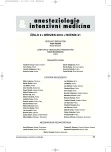First Aid Courses (basic life support) for parents of pre-term newborns – a retrospective analysis of questionnaires
Authors:
Kaniok Radek 1; Veselá Petra 2; Marešová Jana 2; Mareš Jiří 3; Pečenková Jaroslava 3; Černý Vladimír 1
Authors‘ workplace:
Klinika anesteziologie, resuscitace a intenzivní medicíny, Univerzita Karlova v Praze, Lékařská fakulta v Hradci Králové, Fakultní nemocnice Hradec Králové
1; Dětská klinika, Univerzita Karlova v Praze, Lékařská fakulta v Hradci Králové, Fakultní nemocnice Hradec Králové
2; Ústav sociálního lékařství, Univerzita Karlova v Praze, Lékařská fakulta v Hradci Králové
3
Published in:
Anest. intenziv. Med., 21, 2010, č. 2, s. 91-94
Category:
Resuscitation - Original Article
Overview
Objective:
The aim of this study was to assess the participants‘ retrospective feedback on the courses.
Design:
Retrospective analysis.
Setting:
Department of Anaesthesiology and Intensive Care, Department of Paediatrics, University Hospitál.
Materials and methods:
We analysed 100 questionnaires in this retrospective study. The questionnaires were filled in by the pre-term newborns‘ parents who took the first aid course between October 2006 and January 2009. The participants answered eight questions on a five degree scale. We analysed the results using descriptive statistics methods.
Results:
One hundred questionnaires were analysed. The return was 100%. Question: “Have you ever taken a first aid course?” 50% participants answered in the affirmative, 45% negative and 5% respondents did not answer. Question: “Was everything that was said at the course understandable?” 98% participants answered in the affirmative. Question: “Did passing this first aid course benefit you?” 99% participants answered in the affirmative.
Conclusion:
Participants of the courses evaluated the courses and their format positively.
Keywords:
first aid – pre-term newborn – questionnaire
Sources
1. Bydžovský, J. První pomoc. 2. vyd. Praha: Grada Publishing, 2004, 76 s. ISBN 80-247-0680-6.
2. Gil, L., Herbon, F. , Little, A. et al. Investigation of the causes of infant sudden unexpected death in children younger than one year in Bariloche city and surrounding areas. Arch. Argent. Pediatr., 2008, 6, p. 518–523.
3. Grupo de trabajo en muerte súbita del lactante. Nuevas recomendaciones para la disminución del riesgo del síndrome de muerte súbita del lactante. Arch Argent Pediatr, 2000, 98, p. 239–243.
4. Hauck, F. R. Changing epidemiology. In Byard, R. W., Krous, H. F. Sudden infant death syndrome. Problems, progress and possibilities. London: Arnold, 2004, p. 31–57.
5. Hunt, C., Hauk, F. Sudden Infant Death Syndrome. CMAJ, 2006, 174, p. 1861–1869.
6. Kaniok, R., Veselá, P. Výuka první pomoci metodou e-learningu určená rodičům rizikových novorozenců. In Schwarz, D., Dušek, L., Štípek, S., Mihál, V. Konference Mefanet 2008. Brno : Masarykova univerzita, 2008, s. 31.
7. Malloy, M. H., MacDorman, M. Changes in the classification of sudden unexpected infant deaths: United States, 1992–2001. Pediatrics, 2005, 115, p. 1247–1253.
Labels
Anaesthesiology, Resuscitation and Inten Intensive Care MedicineArticle was published in
Anaesthesiology and Intensive Care Medicine

2010 Issue 2
Most read in this issue
- The effect of transversus abdominis plane block on post-operative pain relief: a prospective audit
- Multimodal monitoring in neurointensive care of severe traumatic brain injury
- Tomas Kadlic Memorial – Ass. Prof. Tomas Kadlic, M. D.
- Influence of age on the pharmacodynamic parameters of cisatracurium, rocuronium and vecuronium in males during total intravenous anaesthesia – a prospective study
